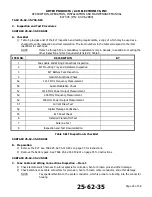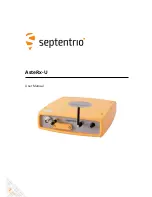
ARTEX PRODUCTS / ACR ELECTRONICS, INC
DESCRIPTION, OPERATION, INSTALLATION AND MAINTENANCE MANUAL
ELT 345 (P/N: A3-06-2880)
Page 17 of 58
25-62-35
DESCRIPTION AND OPERATION
TASK 25-62-35-870-801
1.
Description
SUBTASK 25-62-35-870-001
A.
Functional Overview
1)
The ELT automatically activates during a crash and transmits a continuous standard sweep tone on the 121.5
MHz frequency. Approximately every 50 seconds, the 406 MHz transmitter turns on and transmits an encoded
signal of either 440ms or 520ms, depending on the beacon programming protocol. This message is received by
the COSPAS-SARSAT Search and Rescue (SAR) satellite system.
2)
The information contained in the message includes:
a)
Beacon serial number, or
b)
Aircraft identification or registration number
c)
Country of registration and country code
d)
Position coordinates, if beacon is programmed to receive position data from the aircraft navigation system
3)
When the 406 MHz signal is detected by the Cospas–Sarsat satellite system, a position is calculated and the
121.5 MHz signal is used to home in on the crash site.
4)
The 406 MHz transmitter will operate in this mode for 24 hours and then shut down automatically. The 121.5
MHz transmitter (homer transmitter) will continue to operate until the batteries are exhausted, which is at least
50 hours.
5)
The location accuracy of the 406 MHz transmitter is typically 3 km. If position information is extracted from the
aircraft navigation system, the accuracy improves to approximately 100 meters (standard or national location
protocol).
6)
The 406 MHz digital message provides search and rescue authorities the information to contact the
owner/operator of the aircraft through information contained in a database. The database may include:
a)
Type of aircraft and aircraft registration number,
b)
Owner address and telephone number, and
c)
Alternate emergency contact.
7)
Previous to February 9, 2009, the COSPAS-SARSAT system used the 121.5 MHz signal as an aid to determine
beacon location. As of this date, the use of this signal for satellite location has been terminated, as the accuracy
proved too poor. 406 MHz capable ELTs replace the older Class B beacons.
8)
Aircraft communications transceivers are not capable of receiving 406 MHz transmissions; therefore, the only
methods of monitoring the ELT are:
a)
The blinking cockpit remote switch LED,
b)
The buzzer, or
c)
121.5 MHz transmissions, which can be monitored using the aircraft communications transceiver or an AM
radio tuned to the frequency 121.5 MHz.
















































